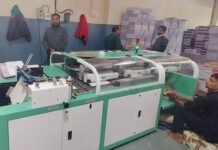Naph Graphics, a web offset manufacturer that still makes these presses for newspaper and book printing, however, received a good response for the turret slitter-rewinder it launched at the recent PlastIndia in Delhi. Its earlier slitter-rewinder that was very high-end has been made cost-effective claims Mohit Bansal, the assistant director-marketing of the Noida company.
Bansal said, “The sales inquiries have been frequent since January and till February we closed around 7 deals, but March was relatively slower. Our participation in PlastIndia was quite last minute so our machine was held off from display, but our launch was still successful. One turret slitter-rewinder is already in transit to a customer, another is being set up to be dispatched. March had holidays such as Holi and it was also the month for year-end financial closings so slower business is the result. Our web offset market has been stagnant for a while within India but is doing better in neighboring markets such as Bangladesh, Nepal, and Burma.”
Exhibitions and launches
According to Bansal, although the company’s last-minute participation in the plastics exhibition was good it could have been better. “We did bag several orders in February, but at the exhibition, we were located at such an obscure location that the desired footfalls couldn’t be achieved. Although many visitors found our booth in Pragati Maidan, including those we invited and the response was good, we had higher expectations, and we remain optimistic of more business in the upcoming months.”
With its diversification to flexible packaging, Naph Graphics is targeting rotogravure customers with its stack flexo press. Bansal notes, “When it comes to rotogravure the quality is what should matter, and we feel that with the currently available technology in the Indian market users don’t get the desired results. At the last PrintPack exhibition, we launched a 4-color stack flexo press and we can say that the technology, if not the best, is many times better than what many customers are currently using. Our machine runs at a production speed of 120 meters per minute.”
Pandemic made possible
Bansal says that before the pandemic, printing and packaging were not something talked about by the general population, “After the pandemic consumers started realizing the significance of the right choice of products, and the focus was shifted from cheap and readily available to quality and cost-effectiveness. The industry also became more customer-centric and focussed more on retaining customers than targeting new customers.”
“I cannot comment if the industry is truly booming but there is progress, and it is more tangible than before. We are in the process of learning, and one thing we learned is that the ups and downs are what keep the industry running. No one is the boss of everything and that is the best part – sustainability, and innovation are the leading drivers of change in today’s economy, and the better solution a company provides in turn motivates another to work on something more interesting”, he adds.
















